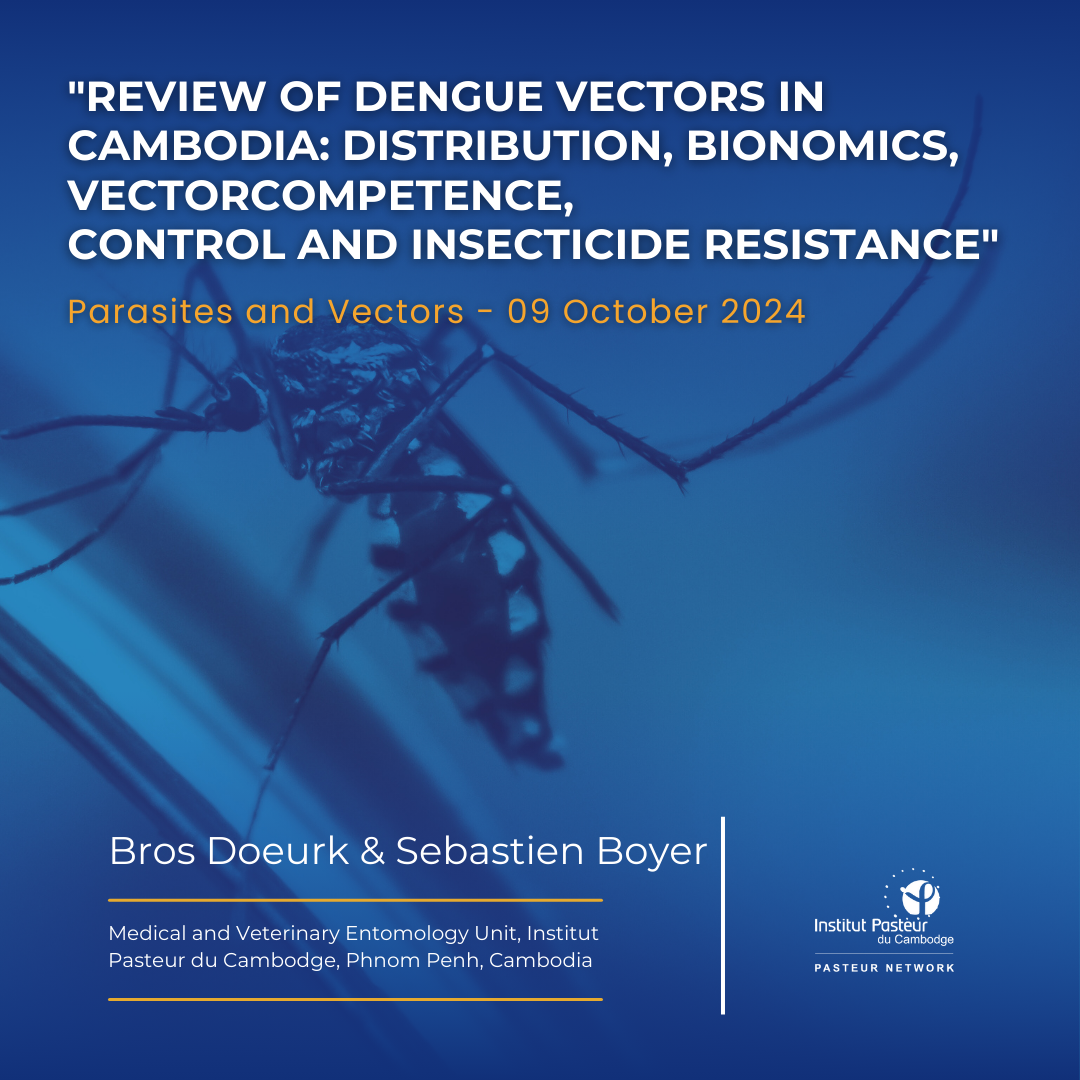Review of dengue vectors in Cambodia: distribution, bionomics, vector competence, control and insecticide resistance"
Journal: Parasites and Vectors
Short abstract in English:Review of dengue vectors in Cambodia
Dengue fever is one of the most prevalent mosquito-borne diseases in Cambodia. Until now, no specific vaccine nor antiviral treatment exists the virus causing Dengue fever. Consequently, its prevention relies only on vector control strategies. However, efficient vector control in turn relies on a good knowledge of the biology of the vector species. Therefore, this study aims to provide the first review of the distribution, ecology, meteorological impacts, trophic behavior, vector competence, vector control and insecticide resistance of dengue vector species in Cambodia.
Methods
A systematic search of the Google Scholar and PubMed databases was conducted for relevant published articles. Of the 610 published articles originally identified, 70 articles were ultimately selected for inclusion in this review. We also included new data from unpublished research conducted in Cambodia between 2017 and 2023 related to dengue vector bionomics.
Results
Eleven Aedes (Stegomyia) mosquito species have been recorded in Cambodia, including a new species described in 2024. Four species are associated with dengue virus transmission, among which Aedes aegypti and Ae. albopictus are the main vectors and Ae. malayensis and Ae. scutellaris are considered to be potential vectors. Aedes aegypti and Ae. albopictus are present in all provinces of Cambodia. Aedes albopictus shows a preference for forest, rural and suburban areas, while Ae. aegypti is mostly found in urban and suburban areas. The distribution of these two species is also influenced by meteorological factors, seasonality and the availability of breeding habitats and blood meals. Both species are predominant during the rainy season, and their respective density is impacted by precipitation and temperature. Aedes aegypti is characterized as anthropophilic, while Ae. albopictus exhibits zooanthropophilic behavior, and both species have been observed to be predominantly diurnal. In addition, they were found to be highly resistant to the insecticides used in Cambodia for their control, such as temephos for larvae and deltamethrin and permethrin for adult mosquitoes.
Conclusions
This review provides extensive and important knowledge on dengue vectors in Cambodia. This knowledge is derived not only from published research articles but also from many recent studies in Cambodia on the bionomics of dengue vector species. The review provides valuable information for use by public health authorities on dengue virus transmission and to develop better vector control strategies in the country.
Short abstract in Khmer:
ជំងឺគ្រុនឈាម គឺជាជំងឺចម្លងដោយសត្វមូស ដែលមានហាន្និភ័យខ្ពស់ជាងគេនៅក្នុងប្រទេសកម្ពុជា។ មកដល់ឥលូវនេះពុំទាន់មានវ៉ាក់សាំងបង្ការ ឬការព្យាបាលជាក់លាក់ លើវីរុសរបស់គ្រុនឈាមនៅឡើយទេ។ ការបង្ការគឺពឹងផ្អែកលើការវិធីសាស្រ្តក្នុងការគ្រប់គ្រងភ្នាក់ងារចម្លង។ ដោយឡែកការគ្រប់គ្រងដែលមានប្រសិទ្ធិភាពគឺអាស្រ័យទៅលើចំណេះដឹងផ្នែកជីវសាស្ត្រនៃភ្នាក់ងារចម្លងទាំងនេះ។ ដូច្នេះការសិក្សានេះមានគោលបំណងក្នុងការសំយោគ អំពីនានាភាព អេកូឡូស៊ី ឥទ្ធិពលនៃអាកាសធាតុ អាកប្បកិរិយានៃការរកចំណី សមត្ថភាពក្នុងការចម្លងជម្ងឺ វិធីសាស្ត្រគ្រប់គ្រង និងភាពធន់ទៅនឹងថ្នាំសម្លាប់សត្វល្អិត នៃភ្នាក់ងារចម្លងជំងឺ គ្រុនឈាមនៅប្រទេសកម្ពុជា។
វិធីសាស្រ្ត៖ ប្រព័ន្ធនៃការស្វែងអត្ថបទដែលបានបោះពុម្ភនៅក្នុង Google Scholar និង PubMed បានកំណត់អត្ថបទពាក់ព័ន្ធចំនួន 610 ដែលក្នុងនោះមាន 70 អត្ថបទត្រូវបានជ្រើសរើសសម្រាប់ការដាក់បញ្ចូលក្នុងការសំយោគ។ លើសពីនេះទៅទៀត ទិន្នន័យដែលមិនទាន់បានបោះពុម្ភផ្សាយក្នុងអំឡុងឆ្នាំ 2017 ដល់ឆ្នាំ 2023 ស្តីអំពីជីវសាស្ត្រនៃភ្នាក់ងារចម្លងជម្ងឺគ្រុនឈាមត្រូវបានដាក់បញ្ចូលបន្ថែមនៅក្នុងការសិក្សានេះ។
លទ្ធផល៖ ប្រភេទសត្វមូស Aedes (Stegomyia) ចំនួន 11 ប្រភេទ ត្រូវបានគេកំណត់អត្តសញ្ញាណនៅក្នុងប្រទេសកម្ពុជា រួមទាំងប្រភេទសត្វមូសថ្មី ដែលត្រូវបានពិពណ៌នាក្នុងឆ្នាំ 2024 ។ មានសត្វមូស 4 ប្រភេទដែលមានការជាប់ទាក់ទងទៅនឹងការចម្លងជំងឺគ្រុនឈាម ក្នុងនោះដែរមូសប្រភេទ Aedes aegypti និង Ae. albopictus ជាភ្នាក់ងារចម្លងជម្ងឺគ្រុនឈាមចម្បង និងមូសប្រភេទ Ae. malayensis និង Ae. scutellaris ក៏អាចជាភ្នាក់ងារចម្លងជម្ងឺគ្រុណឈាមដ៍មានសក្តានុពលផងដែរ។ ចំពោះ Aedes aegypti និង Ae. albopictus គឺមានវត្តមាននៅទូទាំងខេត្តទាំងអស់ក្នុងប្រទេសកម្ពុជា។ គួអោយកត់សំគាល់ផងដែរថាសត្វមូសប្រភេទ Ae. albopictus ចូលចិត្តរស់នៅក្នុងតំបន់ព្រៃឈើ ខណៈពេលដែលប្រភេទ Ae. aegypti ត្រូវបានរកឃើញជាចម្បងនៅក្នុងទីប្រជុំជន។ កត្តាអាកាសធាតុ រដូវកាល កត្តាទីជម្រករបស់ដ្កូវទឹក និងប្រភពឈាម ជះឥទ្ធិពលដល់នានាភាពរបស់មូសទាំងពីរប្រភេទនេះ ដែលមូសទាំងពីរប្រភេទនេះមានការកើនឡើងខ្លាំងនៅក្នុងរដូវវស្សា។ មូសប្រភេទ Ae. aegypti គឺមានចំណូលចិត្តបឺតឈាមមនុស្ស (anthropophilic) ខណៈពេលដែលមូសប្រភេទ Ae. albopictus មានចំណូលចិត្តបឺតឈាមទាំងសត្វ ទាំងមនុស្ស (zooanthropophilic) ហើយទាំងពីរប្រភេទនេះមានភាពសកម្មខ្លាំងក្នុងអំឡុងពេលថ្ងៃ។ លើសពីនេះទៅទៀតពួកគេត្រូវបានរកឃើញថាមានភាពធន់ខ្លាំងទៅនឹងថ្នាំសម្លាប់សត្វល្អិតដែលបានប្រើប្រាស់នៅក្នុងប្រទេសកម្ពុជាដូចជា temephos ជាប្រភេទថ្នាំប្រើប្រាស់សម្រាប់គ្រប់គ្រងដង្កូវទឹក និង deltamethrin និង permethrin ជាប្រភេទថ្នាំប្រើប្រាស់សម្រាប់គ្រប់គ្រងសត្វមូស។
សេចក្តីសន្និដ្ឋាន៖ ការសំយោគបានបង្ហាញនូវចំណេះដឹងសំខាន់ៗស្តីពីភ្នាក់ងារចម្លងជំងឺគ្រុនឈាមនៅក្នុងប្រទេសកម្ពុជា។ ចំណេះដឹងនេះមិនត្រឹមតែបានមកពីការស្រាវជ្រាវដែលបានបោះពុម្ពផ្សាយប៉ុណ្ណោះទេ ប៉ុន្តែក៏បានរួមបញ្ចូលទាំងការសិក្សាស្រាវជា្រវថ្មីៗទាក់ទងទៅនឹងជីវវសាស្ត្ររបស់ភ្នាក់ងារចម្លងជម្ងឺគ្រុនឈាមនៅប្រទេសកម្ពុជាផងដែរ។ ការសំយោគនេះផ្តល់ពត៌មានដ៏មានសារៈសំខាន់សម្រាប់ការប្រើប្រាស់ក្នុងវិស័យសុខភាពសាធារណៈ ទៅលើការចម្លងជម្ងឺគ្រុនឈាម និងពង្រឹងយុទ្ធសាស្ត្រក្នុងការគ្រប់គ្រងភ្នាក់ងារចម្លងជំងឺគ្រុនឈាមនៅក្នុងប្រទេស។



